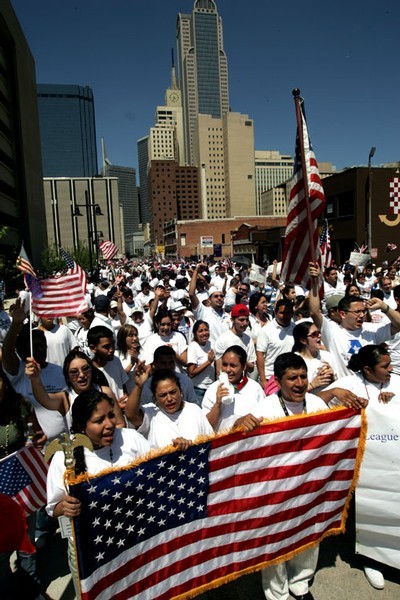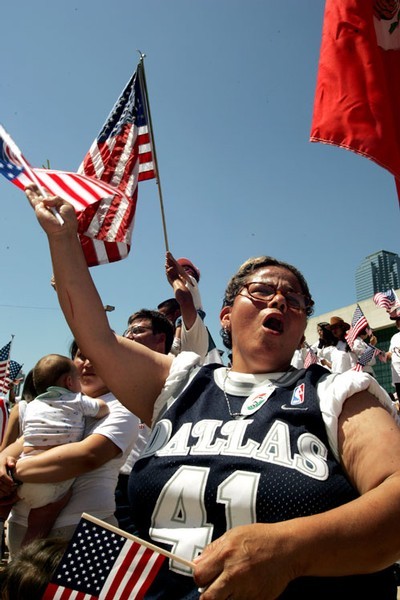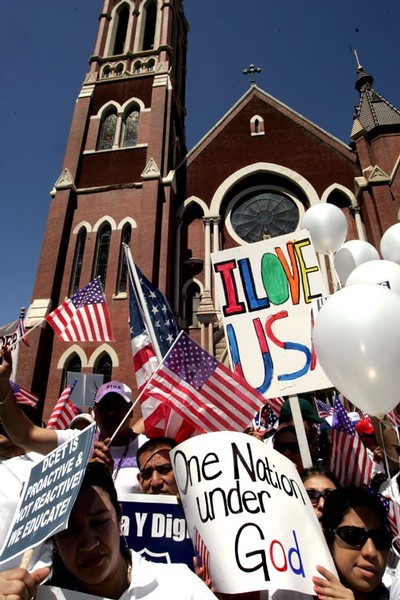
Up to half a million march for immigrant rights in largest protest in Dallas history (by John Schreiber, The Daily Campus)
The largest crowd in Dallas history descended on downtown Sunday to march for immigrant rights. The protest featured a mix of families and veteran activists who walked from Cathedral de Guadalupe to Dallas City Hall.
The march was part of a two-day effort nationwide to attract more attention to the immigration issue. Additional protests took place Monday in New York, San Diego, Houston and Austin.
Police estimates placed the crowd as a high as 500,000 — a record for any Dallas protest. Participants banged drums, waved U.S. flags and wore white at the urging of organizers to symbolize peace.
Shouting “Si Se Puede!” × Spanish for “Yes, we can!” — the marchers peacefully weaved their way through the downtown canyons.
One protestor along the route said, “Everybody wants a chance; that’s why everybody is together.”
They marched urging federal lawmakers to pass immigration reform that would legalize an estimated 11 million undocumented immigrants.
Signs along the route ranged from “Justice and Liberty for all,” “All we need is opportunity” and “We have a dream, too.”
Javier Ortiz attended the Dallas march with the Lord’s Church, an independent Christian church located in Oak Cliff.
Ortiz said the march took on special meaning because it occurred on Palm Sunday, the day Jesus arrived in Jerusalem. Some marchers held palms as they walked through the streets.
“People need more opportunity, more open space, more freedom to walk in the streets without the fear that immigration will get them and send them back to their home country,” said Ortiz.
Notable marchers included Bishop Charles Grahmann of the Dallas Diocese, politicians Rep. Royce West, state Rep. Rafael Anchia and some Dallas City Council members.
The event also featured a voter registration drive by area activists. Several of the speakers at city hall reminded marchers to stay involved in the movement by voting in this year’s elections. The crowd responded with the chant of “hoy marchamos; mañana votamos” – today we march; tomorrow we vote.
Nationwide, voter registration and citizenship education initiatives are set to begin in several states after a “Day Without an Immigrant” campaign planned for May 1, an event that asks immigrants nationwide to stay home from work and school and refrain from buying U.S. products.
Dallas area leaders had their own version of the May 1 event Monday by asking marchers and area Hispanics not to spend any money — and if possible, not show up for work. They wanted to demonstrate the impact Hispanics had locally. However, such boycotts are hard to measure economically.
A small group of counter-protestors shouted from a parking lot at Ross Avenue and Harwood Street. They were boisterous — but remained peaceful and did not affect the march.
Sunday also saw marchers visit downtown Fort Worth. The march there was significantly smaller — crowd estimates were between 10,000 and 30,000. Several demonstrations drew thousands of protesters Sunday in New Mexico, Minnesota, Michigan, Iowa, Alabama, Utah, Oregon, Idaho and California.
Religious groups nationwide have been coordinating the protests in recent weeks, along with dozens of unions, schools and civil rights organizations.
Many groups had been preparing to rally since December, when the House passed a bill to build more walls along the U.S.-Mexico border; make criminals of people who helped undocumented immigrants; and make it a felony, rather than a civil infraction, to be in the country illegally.
Some of the most widespread demonstrations took place Monday.
In the nation’s capital, thousands of immigrants, their families and supporters marched Monday from Hispanic neighborhoods past the White House, then converged on the National Mall.
Thick crowds gathered in New York’s Washington Square Park before marching to City Hall. Many waved flags, both American and of countries of their origin. Korean-Americans beat drums nearby. Another group marched from Chinatown, and a third demonstration took place in Brooklyn.
Police declined to estimate the size of the crowds, but organizers said 125,000 people were present at City Hall.
In Atlanta, many in white T-shirts, waving American flags, joined a two-mile march from a largely immigrant neighborhood.
The Rev. James Orange from the Georgia Coalition for the People’s Agenda compared the march to civil rights demonstrations led by the Rev. Martin Luther King Jr. and farm-labor organizer Cesar Chavez.
In Pittsburgh and other cities, protesters gathered outside lawmakers’ offices. At the Mississippi Capitol, they sang “We Shall Overcome” in Spanish.
Supporters in San Diego planned to hold a ceremony to honor immigrants who died while illegally crossing the border. An evening rally was scheduled in Los Angeles.
In Phoenix, police estimated that at least 50,000 people marched from the state fairgrounds to the Capitol for a rally; protest organizers put the number at 80,000 to 100,000.
Exit ramps were closed and traffic on freeways through downtown was backed up for miles. At one point, the crowd stretched more than two miles.
In Houston, event organizers estimated that 50,000 people gathered at a park in a largely Hispanic area of town as they rallied to march toward the spot where the city’s founders first arrived.
— Jessica Savage and the Associated Press contributed to this report.

Up to half a million march for immigrant rights in largest protest in Dallas history (by John Schreiber, The Daily Campus)

Up to half a million march for immigrant rights in largest protest in Dallas history (by John Schreiber, The Daily Campus)








